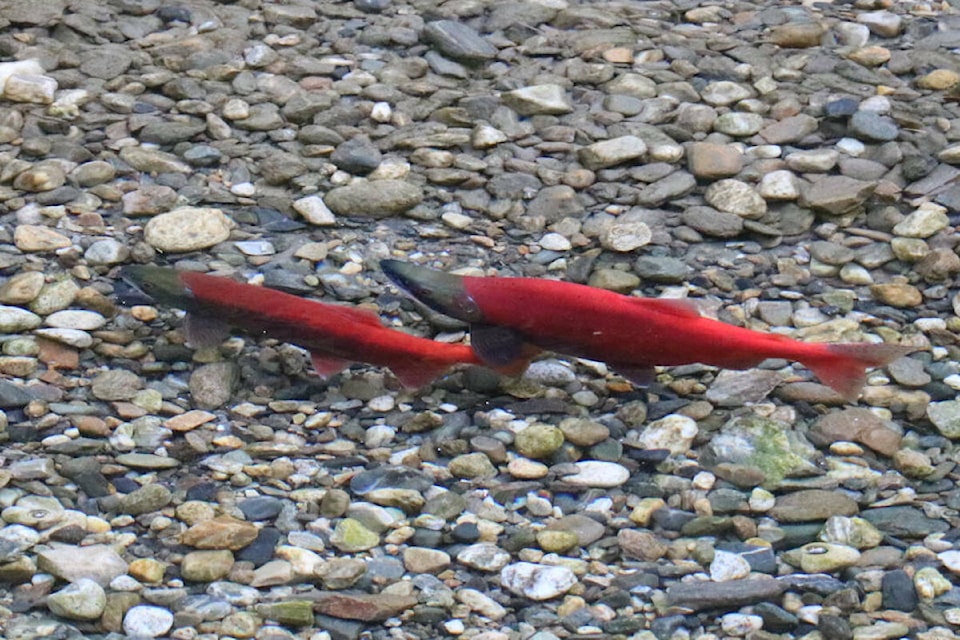The Yaqan Nukiy Lower Kootenay Band and B.C. Wildlife Federation say hydro dams in southeastern B.C. are responsible for decades of harm to kokanee salmon because of unnatural and artificially fluctuating water levels.
They are asking the federal fisheries minister to investigate B.C. Hydro and FortisBC, alleging the companies have violated the Fisheries Act in multiple ways for decades.
“It is a strange world that we live in,” said BCWF executive director Jesse Zeman, “where we have to ask the Government of Canada Department of Fisheries and Oceans to follow its own rules.”
Zeman was referring to section 35 of the federal Fisheries Act, which prohibits any work that would result in “the harmful alteration, disruption or destruction of fish habitat.”
The University of Victoria Environmental Law Centre is assisting the groups with this initiative.
In an Aug. 16 letter to Minister of Fisheries and Oceans Dianne Lebouthillier, the law centre explained that changes in lake levels and the hydrology of the West Arm of Kootenay Lake caused by the operation of dams run by BC Hydro (Corra Linn built in 1932 and Duncan in 1967) and Fortis (Kootenay Canal dam completed in 1976) have severely depressed the genetically distinct populations of kokanee salmon.
The kokanee are a land-locked salmon that do not migrate. Kokanee in the West Arm are a distinct population consisting of shore spawners and stream spawners.
Shore spawners lay their eggs in shoreline gravel, and after they hatch in the spring, the fry reside on the shoreline for several weeks before moving to the open waters. The stream-spawner fry also spend at least a month just offshore after emerging in the spring. The health and stability of the shoreline is therefore crucial to kokanee survival.
The West Arm was once home to hundreds of thousands of kokanee salmon, but the spawning population today is currently fewer than 7,000 fish, according to Zeman. Because the companies cause water levels to rise in the fall, spawning takes place higher up the shore, he said, and this area is then dried out when the companies bring down the water levels in the spring.
A company intending to carry out work such as hydroelectric development is supposed to get a permit from the ministry, Zeman said, but hydro companies have never applied for permits and the department has never required them to do so.
The priority has been power generation, and the fishery has been ignored, he said.
“The Columbia Basin has been a disaster for fish and wildlife populations ever since the province approved all of these dams,” Zeman said. “Neither the province of British Columbia nor the Government of Canada have met their legislative, regulatory or moral obligations in the area. The tail has been wagging the dog for decades.”
He said the Fish and Wildlife Compensation Program, set up to provide compensation for damage to fish habitat using money transferred from the U.S. through the Columbia River Treaty, has been too limited and not done its job.
The Nelson Star reached out to BC Hydro and the Department of Fisheries and Oceans for comment, but has received no reply. FortisBC responded that it is aware of the law centre letter and is reviewing its contents.
Robin Louie of the Lower Kootenay Band is one of the signatories of the letter to the fisheries minister.
“I’m always on the land and I’m sick of seeing kokanee eggs on the shore all dried out,” he said in a news release. “Kokanee is the nasukin (chief) of the water, the eagle is the nasukin of the sky, and the grizzly is the nasukin of the land. They are all interrelated and they need each other.”
He said the band is engaged in several long-term wetland and fish habitat restoration projects, but the Kokanee are unlikely to recover if the hydroelectric companies don’t change their operations or adequately fund a recovery.
Lawyer Charis Kamphuis, author of the letter to the minister, said they are requesting the government require the companies to mitigate damage more effectively and/or impose fines and penalties for past harm.
“It’s their job to kind of make sure that the law is applied to protect fish,” she said. “So effectively, we’re just asking them to do their job.”
Kamphuis said the companies have taken some partial mitigation measures recently, but there is evidence they have known about this damage to the fishery for at least 15 years.
“It’s not OK that the measures they have taken are purely voluntary and at their own discretion. … We are calling on the federal authorities to ensure that mitigation measures are mandatory and that there’s oversight.”
Kamphuis and Zeman said the provincial government is also at fault because it has issued water licences to the companies without any assessment of environmental impacts, and it has not properly funded the mitigation of harm to the kokanee.
They said they intend to take up this issue separately at a later date.
READ MORE:
• Kootenay Lake kokanee spawning numbers a growing concern
• COLUMN: How to repair the Kootenay Lake fishery
• Kokanee’s name spread far and wide
• COLUMN: Advocating for the Salmon Spirit
bill.metcalfe@nelsonstar.com
Sign up for the Nelson Star’s newsletter here to have local stories delivered straight to your inbox every morning.
